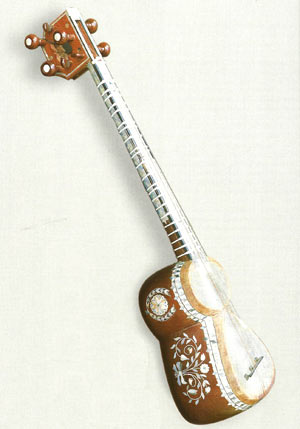Home page
» MUSIC APPLIANCES
» String instruments
» Tar
Tar It is the best and perfect modern musical instrument among stringed musical instruments of Azerbaijan in respect of technical and dynamic abilities. Tar in Persian means wire, thread. Like wise other musical instruments, of course, the modern tar was formed based on an ancient stringed musical instruments and formed for centuries. The name of tar is met in works of our c classics like Gatran Tabrizi, Nizami, Mohammed Fizuli and others. Stringed musical instruments like du tar, se tar, chahar tar, panj tar and shesh tar are considered various types of tar. Abdulqadir Maragi’s Maqasid al-alhan provides information about shesh tar (6 stringed) and describes it widely. The modern tar performance began the stage of strong development in the twentieth century. Thus, in 1931, in the Orchestra of Folklore Musical Instruments with first note created at the initiative of M. Magomayev and U. Hajibayov tar occupied a position of leading instrument. The school note performance founded by U. Hajibeyov had increased the technical and artistic possibilities of tar. Tar was used mainly in the structure of the Mugham trio (tar, kamancha, tambourine) as a lead instrument and plays a significant role in the development of mugam art today. In mugam operas solo singing is performed by the accompaniment of tar. Azerbaijani composers wrote many large concerts with the tar and the orchestra. Differing from other stringed instruments in respect of structure and form, tar consists of three parts - body, arm and head. Body of tar is made of mulberry, arm and head are made of walnut wood. The total length is 850 mm, body’s height is 165 mm, a width is 185 mm. 1. White, yellow, and the tune strings (there is a pair of each). 2. The tune string (a single thick string is only performed with mugham). 3. Call strings (jingana- is of two pairs). To provide technical and artistic possibilities of during playing, trel and various mizrab beating methods, codes are used. In addition to upper mizrab, lower-mizrab, upper-lower-mizrab, lower-upper-mizrab, rukh (right-left) mizrab, santur-mizrab (top-down-top) and other codes, the dumb finger (vibration) , scrolling, slipping finger (qlissando) and methods are also used. Artist beats with mizrab in string and by pressing tar in breast makes sound waved for a long time. The effect occurred during a break is called khum. Notes for tar are written in do system mezzo-soprano key. Sound structure of tar is chromatic, and covers 2.5 octave. Its diapason is from small octave’s do to the second octave’s sol sound.
|
